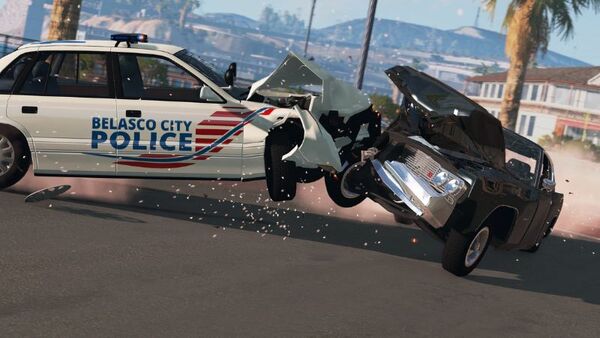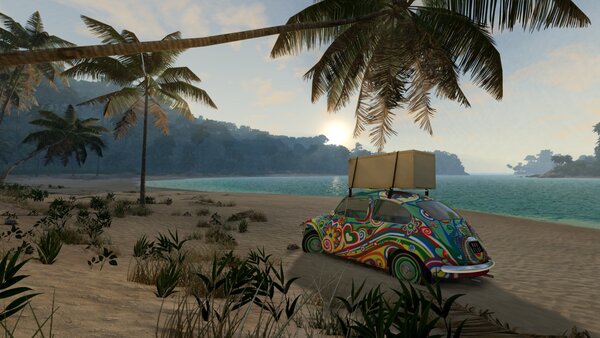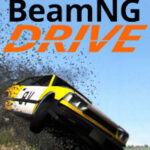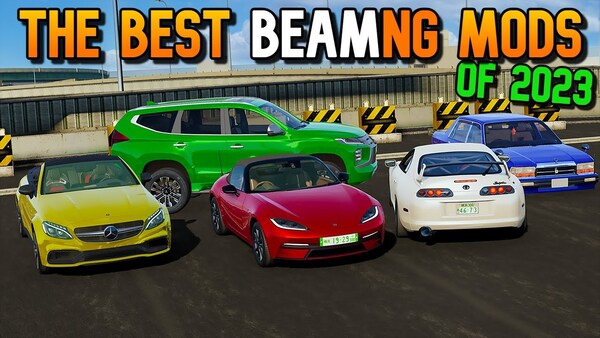Advertisement
Popular Now
Introduction
BeamNG.drive is renowned for its incredibly realistic vehicle physics, making it a favorite among car enthusiasts and simulation gamers. Unlike many other racing or driving games, BeamNG.drive doesn’t just simulate speed and handling-it replicates the intricacies of vehicle behavior in ways that allow for a deeply immersive driving experience. The game’s soft-body physics engine plays a pivotal role in this realism, affecting everything from suspension dynamics to crash impacts. In this article, we’ll take a deep dive into the soft-body physics system, understanding how it works, and providing practical tips to enhance your experience.
[caption id="attachment_1227" align="aligncenter" width="600"] Soft-body physics is the core technology that sets BeamNG.drive apart[/caption]
Understanding Soft-Body Physics
Soft-body physics is the core technology that sets BeamNG.drive apart. Unlike traditional racing games where cars have fixed shapes and behaviors, soft-body physics simulates the flexibility of materials, meaning that each part of a vehicle responds dynamically to forces such as gravity, friction, and impact.
BeamNG’s soft-body system allows for:
Real-time Deformation – Every crash results in unique damage patterns.
Component-Specific Reactions – Each part of the vehicle, from the frame to the tires, reacts individually based on its materials and the forces applied.
Fluid Simulations – It replicates how fuel sloshes in a tank or oil leaks during a crash.
The Importance of Suspension Tuning
Suspension tuning in BeamNG.drive isn’t just a cosmetic tweak—it’s critical for handling different terrains and driving conditions. Understanding suspension dynamics will give you more control over your vehicle.
Adjusting Dampers and Springs – Increase damper strength for smoother roads and reduce them for off-road driving to absorb bumps effectively.
Suspension Geometry – Changing camber angles can improve cornering grip but may reduce tire longevity. Balance is key.
Anti-roll Bars – These can reduce body roll during sharp turns, making your vehicle more stable at high speeds.
How Tires Impact Performance
Tires in BeamNG.drive play an essential role in how your vehicle behaves. Choosing the right type of tire for specific scenarios can drastically improve performance.
Tread Patterns – Select off-road tires for muddy and uneven surfaces, while slick tires provide the best grip on paved roads.
Pressure Adjustments – Lower tire pressure improves traction on softer terrain but decreases speed. Higher pressure is ideal for racing on asphalt.
Wear and Tear – Over time, your tires wear out, affecting grip and handling. Monitor tire condition, especially during long scenarios.
Aerodynamics and Vehicle Behavior
Aerodynamics in BeamNG.drive influence not only top speed but also handling and stability. Understanding how airflow affects your vehicle is crucial, especially for high-speed racing.
Spoilers and Wings – Adding a rear wing increases downforce, helping keep your car planted during high-speed turns. Too much downforce, however, can slow you down on straights.
Drag Coefficients – Vehicles with high drag will struggle to reach top speeds. Reducing drag by modifying your vehicle’s body shape can increase speed.
Weight Distribution – The placement of weight (especially in cars with added components like luggage or spare tires) affects balance and handling during turns or under heavy braking.
Crashing and Damage Models
One of the standout features of BeamNG.drive is its realistic crash dynamics. The game’s soft-body physics allows for accurate damage simulation, meaning every crash is unique.
[caption id="attachment_1228" align="aligncenter" width="600"]
Soft-body physics is the core technology that sets BeamNG.drive apart[/caption]
Understanding Soft-Body Physics
Soft-body physics is the core technology that sets BeamNG.drive apart. Unlike traditional racing games where cars have fixed shapes and behaviors, soft-body physics simulates the flexibility of materials, meaning that each part of a vehicle responds dynamically to forces such as gravity, friction, and impact.
BeamNG’s soft-body system allows for:
Real-time Deformation – Every crash results in unique damage patterns.
Component-Specific Reactions – Each part of the vehicle, from the frame to the tires, reacts individually based on its materials and the forces applied.
Fluid Simulations – It replicates how fuel sloshes in a tank or oil leaks during a crash.
The Importance of Suspension Tuning
Suspension tuning in BeamNG.drive isn’t just a cosmetic tweak—it’s critical for handling different terrains and driving conditions. Understanding suspension dynamics will give you more control over your vehicle.
Adjusting Dampers and Springs – Increase damper strength for smoother roads and reduce them for off-road driving to absorb bumps effectively.
Suspension Geometry – Changing camber angles can improve cornering grip but may reduce tire longevity. Balance is key.
Anti-roll Bars – These can reduce body roll during sharp turns, making your vehicle more stable at high speeds.
How Tires Impact Performance
Tires in BeamNG.drive play an essential role in how your vehicle behaves. Choosing the right type of tire for specific scenarios can drastically improve performance.
Tread Patterns – Select off-road tires for muddy and uneven surfaces, while slick tires provide the best grip on paved roads.
Pressure Adjustments – Lower tire pressure improves traction on softer terrain but decreases speed. Higher pressure is ideal for racing on asphalt.
Wear and Tear – Over time, your tires wear out, affecting grip and handling. Monitor tire condition, especially during long scenarios.
Aerodynamics and Vehicle Behavior
Aerodynamics in BeamNG.drive influence not only top speed but also handling and stability. Understanding how airflow affects your vehicle is crucial, especially for high-speed racing.
Spoilers and Wings – Adding a rear wing increases downforce, helping keep your car planted during high-speed turns. Too much downforce, however, can slow you down on straights.
Drag Coefficients – Vehicles with high drag will struggle to reach top speeds. Reducing drag by modifying your vehicle’s body shape can increase speed.
Weight Distribution – The placement of weight (especially in cars with added components like luggage or spare tires) affects balance and handling during turns or under heavy braking.
Crashing and Damage Models
One of the standout features of BeamNG.drive is its realistic crash dynamics. The game’s soft-body physics allows for accurate damage simulation, meaning every crash is unique.
[caption id="attachment_1228" align="aligncenter" width="600"] Vehicles with high drag will struggle to reach top speeds[/caption]
Component-Based Damage – Each crash affects different parts of the vehicle, from the engine to the suspension, altering performance post-collision.
Frame Integrity – Severe impacts can bend or break the vehicle’s frame, drastically reducing its structural integrity.
Post-Crash Behavior – Cars may still be drivable after minor collisions, but steering alignment, engine efficiency, and handling can all be affected.
The Role of Weight and Load Distribution
Weight plays a significant role in how vehicles perform in BeamNG.drive. Too much weight or uneven distribution can make a car sluggish and hard to control.
Center of Gravity – Lowering your car’s center of gravity can improve stability, especially during fast cornering.
Cargo Weight – Loading up your vehicle with heavy items changes how it drives. Trucks, in particular, will handle differently when loaded.
Balancing Load – Make sure weight is distributed evenly across the axles to avoid uneven wear or loss of control in tight turns.
Realistic Off-Roading in BeamNG.drive
Off-roading in BeamNG.drive is far more challenging than in most other games due to its realistic physics engine. Here’s how to prepare your vehicle for off-road adventures:
Tire Selection – Off-road tires with aggressive treads are essential for navigating muddy or rocky terrain.
Suspension Lift – Raising your vehicle's suspension increases ground clearance, allowing for better traversal of uneven landscapes.
Differential Locking – Locking the differential ensures equal power distribution to all wheels, preventing you from getting stuck in challenging terrain.
Mastering Vehicle Control: Steering and Throttle Techniques
Controlling your vehicle in BeamNG.drive requires precise steering and throttle management. The game’s realism means you can’t just floor the accelerator and expect the car to handle well.
Throttle Control – Gradually applying throttle helps maintain traction, especially in rear-wheel-drive cars, where sudden acceleration can cause oversteer.
Steering Sensitivity – Adjusting steering sensitivity helps in different situations. High sensitivity is good for tight maneuvers, while low sensitivity provides more stability on straightaways.
Braking Techniques – Sudden braking can cause your vehicle to lose control, especially on wet surfaces. Practice gradual braking to keep the car steady.
Vehicle Modding and Customization
BeamNG.drive has an active modding community, and vehicle modding is one of the best ways to enhance your experience.
Custom Engines – Modding allows you to swap out engines for more powerful variants, affecting speed, acceleration, and fuel consumption.
Body Modifications – Custom body kits not only improve aesthetics but also influence aerodynamics and weight distribution.
Performance Enhancements – From turbochargers to suspension kits, modding offers endless possibilities for customizing how your vehicle handles.
Physics Tuning for Different Scenarios
Depending on the environment—whether it’s a racetrack or an off-road trail—you’ll need to tune your vehicle’s physics to suit the scenario.
Track vs. Off-road Tuning – Lowering suspension and reducing tire pressure helps on off-road tracks, while higher suspension and slick tires are better for tarmac.
High-Speed Adjustments – For long straightaways, you’ll want to reduce downforce and increase tire pressure to maximize speed.
Weather Effects – In rainy or snowy conditions, traction becomes crucial. Adjust tire grip and throttle response to maintain control on slippery surfaces.
[caption id="attachment_1229" align="aligncenter" width="600"]
Vehicles with high drag will struggle to reach top speeds[/caption]
Component-Based Damage – Each crash affects different parts of the vehicle, from the engine to the suspension, altering performance post-collision.
Frame Integrity – Severe impacts can bend or break the vehicle’s frame, drastically reducing its structural integrity.
Post-Crash Behavior – Cars may still be drivable after minor collisions, but steering alignment, engine efficiency, and handling can all be affected.
The Role of Weight and Load Distribution
Weight plays a significant role in how vehicles perform in BeamNG.drive. Too much weight or uneven distribution can make a car sluggish and hard to control.
Center of Gravity – Lowering your car’s center of gravity can improve stability, especially during fast cornering.
Cargo Weight – Loading up your vehicle with heavy items changes how it drives. Trucks, in particular, will handle differently when loaded.
Balancing Load – Make sure weight is distributed evenly across the axles to avoid uneven wear or loss of control in tight turns.
Realistic Off-Roading in BeamNG.drive
Off-roading in BeamNG.drive is far more challenging than in most other games due to its realistic physics engine. Here’s how to prepare your vehicle for off-road adventures:
Tire Selection – Off-road tires with aggressive treads are essential for navigating muddy or rocky terrain.
Suspension Lift – Raising your vehicle's suspension increases ground clearance, allowing for better traversal of uneven landscapes.
Differential Locking – Locking the differential ensures equal power distribution to all wheels, preventing you from getting stuck in challenging terrain.
Mastering Vehicle Control: Steering and Throttle Techniques
Controlling your vehicle in BeamNG.drive requires precise steering and throttle management. The game’s realism means you can’t just floor the accelerator and expect the car to handle well.
Throttle Control – Gradually applying throttle helps maintain traction, especially in rear-wheel-drive cars, where sudden acceleration can cause oversteer.
Steering Sensitivity – Adjusting steering sensitivity helps in different situations. High sensitivity is good for tight maneuvers, while low sensitivity provides more stability on straightaways.
Braking Techniques – Sudden braking can cause your vehicle to lose control, especially on wet surfaces. Practice gradual braking to keep the car steady.
Vehicle Modding and Customization
BeamNG.drive has an active modding community, and vehicle modding is one of the best ways to enhance your experience.
Custom Engines – Modding allows you to swap out engines for more powerful variants, affecting speed, acceleration, and fuel consumption.
Body Modifications – Custom body kits not only improve aesthetics but also influence aerodynamics and weight distribution.
Performance Enhancements – From turbochargers to suspension kits, modding offers endless possibilities for customizing how your vehicle handles.
Physics Tuning for Different Scenarios
Depending on the environment—whether it’s a racetrack or an off-road trail—you’ll need to tune your vehicle’s physics to suit the scenario.
Track vs. Off-road Tuning – Lowering suspension and reducing tire pressure helps on off-road tracks, while higher suspension and slick tires are better for tarmac.
High-Speed Adjustments – For long straightaways, you’ll want to reduce downforce and increase tire pressure to maximize speed.
Weather Effects – In rainy or snowy conditions, traction becomes crucial. Adjust tire grip and throttle response to maintain control on slippery surfaces.
[caption id="attachment_1229" align="aligncenter" width="600"] In rainy or snowy conditions, traction becomes crucial[/caption]
Conclusion
BeamNG.drive’s realism offers endless depth for players who want to master vehicle behavior. From understanding soft-body physics and crash mechanics to optimizing aerodynamics and mastering off-road scenarios, there’s always something new to learn. Whether you’re driving for fun or working on complex mods, mastering these mechanics will elevate your gameplay experience.
In rainy or snowy conditions, traction becomes crucial[/caption]
Conclusion
BeamNG.drive’s realism offers endless depth for players who want to master vehicle behavior. From understanding soft-body physics and crash mechanics to optimizing aerodynamics and mastering off-road scenarios, there’s always something new to learn. Whether you’re driving for fun or working on complex mods, mastering these mechanics will elevate your gameplay experience.
 Soft-body physics is the core technology that sets BeamNG.drive apart[/caption]
Understanding Soft-Body Physics
Soft-body physics is the core technology that sets BeamNG.drive apart. Unlike traditional racing games where cars have fixed shapes and behaviors, soft-body physics simulates the flexibility of materials, meaning that each part of a vehicle responds dynamically to forces such as gravity, friction, and impact.
BeamNG’s soft-body system allows for:
Real-time Deformation – Every crash results in unique damage patterns.
Component-Specific Reactions – Each part of the vehicle, from the frame to the tires, reacts individually based on its materials and the forces applied.
Fluid Simulations – It replicates how fuel sloshes in a tank or oil leaks during a crash.
The Importance of Suspension Tuning
Suspension tuning in BeamNG.drive isn’t just a cosmetic tweak—it’s critical for handling different terrains and driving conditions. Understanding suspension dynamics will give you more control over your vehicle.
Adjusting Dampers and Springs – Increase damper strength for smoother roads and reduce them for off-road driving to absorb bumps effectively.
Suspension Geometry – Changing camber angles can improve cornering grip but may reduce tire longevity. Balance is key.
Anti-roll Bars – These can reduce body roll during sharp turns, making your vehicle more stable at high speeds.
How Tires Impact Performance
Tires in BeamNG.drive play an essential role in how your vehicle behaves. Choosing the right type of tire for specific scenarios can drastically improve performance.
Tread Patterns – Select off-road tires for muddy and uneven surfaces, while slick tires provide the best grip on paved roads.
Pressure Adjustments – Lower tire pressure improves traction on softer terrain but decreases speed. Higher pressure is ideal for racing on asphalt.
Wear and Tear – Over time, your tires wear out, affecting grip and handling. Monitor tire condition, especially during long scenarios.
Aerodynamics and Vehicle Behavior
Aerodynamics in BeamNG.drive influence not only top speed but also handling and stability. Understanding how airflow affects your vehicle is crucial, especially for high-speed racing.
Spoilers and Wings – Adding a rear wing increases downforce, helping keep your car planted during high-speed turns. Too much downforce, however, can slow you down on straights.
Drag Coefficients – Vehicles with high drag will struggle to reach top speeds. Reducing drag by modifying your vehicle’s body shape can increase speed.
Weight Distribution – The placement of weight (especially in cars with added components like luggage or spare tires) affects balance and handling during turns or under heavy braking.
Crashing and Damage Models
One of the standout features of BeamNG.drive is its realistic crash dynamics. The game’s soft-body physics allows for accurate damage simulation, meaning every crash is unique.
[caption id="attachment_1228" align="aligncenter" width="600"]
Soft-body physics is the core technology that sets BeamNG.drive apart[/caption]
Understanding Soft-Body Physics
Soft-body physics is the core technology that sets BeamNG.drive apart. Unlike traditional racing games where cars have fixed shapes and behaviors, soft-body physics simulates the flexibility of materials, meaning that each part of a vehicle responds dynamically to forces such as gravity, friction, and impact.
BeamNG’s soft-body system allows for:
Real-time Deformation – Every crash results in unique damage patterns.
Component-Specific Reactions – Each part of the vehicle, from the frame to the tires, reacts individually based on its materials and the forces applied.
Fluid Simulations – It replicates how fuel sloshes in a tank or oil leaks during a crash.
The Importance of Suspension Tuning
Suspension tuning in BeamNG.drive isn’t just a cosmetic tweak—it’s critical for handling different terrains and driving conditions. Understanding suspension dynamics will give you more control over your vehicle.
Adjusting Dampers and Springs – Increase damper strength for smoother roads and reduce them for off-road driving to absorb bumps effectively.
Suspension Geometry – Changing camber angles can improve cornering grip but may reduce tire longevity. Balance is key.
Anti-roll Bars – These can reduce body roll during sharp turns, making your vehicle more stable at high speeds.
How Tires Impact Performance
Tires in BeamNG.drive play an essential role in how your vehicle behaves. Choosing the right type of tire for specific scenarios can drastically improve performance.
Tread Patterns – Select off-road tires for muddy and uneven surfaces, while slick tires provide the best grip on paved roads.
Pressure Adjustments – Lower tire pressure improves traction on softer terrain but decreases speed. Higher pressure is ideal for racing on asphalt.
Wear and Tear – Over time, your tires wear out, affecting grip and handling. Monitor tire condition, especially during long scenarios.
Aerodynamics and Vehicle Behavior
Aerodynamics in BeamNG.drive influence not only top speed but also handling and stability. Understanding how airflow affects your vehicle is crucial, especially for high-speed racing.
Spoilers and Wings – Adding a rear wing increases downforce, helping keep your car planted during high-speed turns. Too much downforce, however, can slow you down on straights.
Drag Coefficients – Vehicles with high drag will struggle to reach top speeds. Reducing drag by modifying your vehicle’s body shape can increase speed.
Weight Distribution – The placement of weight (especially in cars with added components like luggage or spare tires) affects balance and handling during turns or under heavy braking.
Crashing and Damage Models
One of the standout features of BeamNG.drive is its realistic crash dynamics. The game’s soft-body physics allows for accurate damage simulation, meaning every crash is unique.
[caption id="attachment_1228" align="aligncenter" width="600"] Vehicles with high drag will struggle to reach top speeds[/caption]
Component-Based Damage – Each crash affects different parts of the vehicle, from the engine to the suspension, altering performance post-collision.
Frame Integrity – Severe impacts can bend or break the vehicle’s frame, drastically reducing its structural integrity.
Post-Crash Behavior – Cars may still be drivable after minor collisions, but steering alignment, engine efficiency, and handling can all be affected.
The Role of Weight and Load Distribution
Weight plays a significant role in how vehicles perform in BeamNG.drive. Too much weight or uneven distribution can make a car sluggish and hard to control.
Center of Gravity – Lowering your car’s center of gravity can improve stability, especially during fast cornering.
Cargo Weight – Loading up your vehicle with heavy items changes how it drives. Trucks, in particular, will handle differently when loaded.
Balancing Load – Make sure weight is distributed evenly across the axles to avoid uneven wear or loss of control in tight turns.
Realistic Off-Roading in BeamNG.drive
Off-roading in BeamNG.drive is far more challenging than in most other games due to its realistic physics engine. Here’s how to prepare your vehicle for off-road adventures:
Tire Selection – Off-road tires with aggressive treads are essential for navigating muddy or rocky terrain.
Suspension Lift – Raising your vehicle's suspension increases ground clearance, allowing for better traversal of uneven landscapes.
Differential Locking – Locking the differential ensures equal power distribution to all wheels, preventing you from getting stuck in challenging terrain.
Mastering Vehicle Control: Steering and Throttle Techniques
Controlling your vehicle in BeamNG.drive requires precise steering and throttle management. The game’s realism means you can’t just floor the accelerator and expect the car to handle well.
Throttle Control – Gradually applying throttle helps maintain traction, especially in rear-wheel-drive cars, where sudden acceleration can cause oversteer.
Steering Sensitivity – Adjusting steering sensitivity helps in different situations. High sensitivity is good for tight maneuvers, while low sensitivity provides more stability on straightaways.
Braking Techniques – Sudden braking can cause your vehicle to lose control, especially on wet surfaces. Practice gradual braking to keep the car steady.
Vehicle Modding and Customization
BeamNG.drive has an active modding community, and vehicle modding is one of the best ways to enhance your experience.
Custom Engines – Modding allows you to swap out engines for more powerful variants, affecting speed, acceleration, and fuel consumption.
Body Modifications – Custom body kits not only improve aesthetics but also influence aerodynamics and weight distribution.
Performance Enhancements – From turbochargers to suspension kits, modding offers endless possibilities for customizing how your vehicle handles.
Physics Tuning for Different Scenarios
Depending on the environment—whether it’s a racetrack or an off-road trail—you’ll need to tune your vehicle’s physics to suit the scenario.
Track vs. Off-road Tuning – Lowering suspension and reducing tire pressure helps on off-road tracks, while higher suspension and slick tires are better for tarmac.
High-Speed Adjustments – For long straightaways, you’ll want to reduce downforce and increase tire pressure to maximize speed.
Weather Effects – In rainy or snowy conditions, traction becomes crucial. Adjust tire grip and throttle response to maintain control on slippery surfaces.
[caption id="attachment_1229" align="aligncenter" width="600"]
Vehicles with high drag will struggle to reach top speeds[/caption]
Component-Based Damage – Each crash affects different parts of the vehicle, from the engine to the suspension, altering performance post-collision.
Frame Integrity – Severe impacts can bend or break the vehicle’s frame, drastically reducing its structural integrity.
Post-Crash Behavior – Cars may still be drivable after minor collisions, but steering alignment, engine efficiency, and handling can all be affected.
The Role of Weight and Load Distribution
Weight plays a significant role in how vehicles perform in BeamNG.drive. Too much weight or uneven distribution can make a car sluggish and hard to control.
Center of Gravity – Lowering your car’s center of gravity can improve stability, especially during fast cornering.
Cargo Weight – Loading up your vehicle with heavy items changes how it drives. Trucks, in particular, will handle differently when loaded.
Balancing Load – Make sure weight is distributed evenly across the axles to avoid uneven wear or loss of control in tight turns.
Realistic Off-Roading in BeamNG.drive
Off-roading in BeamNG.drive is far more challenging than in most other games due to its realistic physics engine. Here’s how to prepare your vehicle for off-road adventures:
Tire Selection – Off-road tires with aggressive treads are essential for navigating muddy or rocky terrain.
Suspension Lift – Raising your vehicle's suspension increases ground clearance, allowing for better traversal of uneven landscapes.
Differential Locking – Locking the differential ensures equal power distribution to all wheels, preventing you from getting stuck in challenging terrain.
Mastering Vehicle Control: Steering and Throttle Techniques
Controlling your vehicle in BeamNG.drive requires precise steering and throttle management. The game’s realism means you can’t just floor the accelerator and expect the car to handle well.
Throttle Control – Gradually applying throttle helps maintain traction, especially in rear-wheel-drive cars, where sudden acceleration can cause oversteer.
Steering Sensitivity – Adjusting steering sensitivity helps in different situations. High sensitivity is good for tight maneuvers, while low sensitivity provides more stability on straightaways.
Braking Techniques – Sudden braking can cause your vehicle to lose control, especially on wet surfaces. Practice gradual braking to keep the car steady.
Vehicle Modding and Customization
BeamNG.drive has an active modding community, and vehicle modding is one of the best ways to enhance your experience.
Custom Engines – Modding allows you to swap out engines for more powerful variants, affecting speed, acceleration, and fuel consumption.
Body Modifications – Custom body kits not only improve aesthetics but also influence aerodynamics and weight distribution.
Performance Enhancements – From turbochargers to suspension kits, modding offers endless possibilities for customizing how your vehicle handles.
Physics Tuning for Different Scenarios
Depending on the environment—whether it’s a racetrack or an off-road trail—you’ll need to tune your vehicle’s physics to suit the scenario.
Track vs. Off-road Tuning – Lowering suspension and reducing tire pressure helps on off-road tracks, while higher suspension and slick tires are better for tarmac.
High-Speed Adjustments – For long straightaways, you’ll want to reduce downforce and increase tire pressure to maximize speed.
Weather Effects – In rainy or snowy conditions, traction becomes crucial. Adjust tire grip and throttle response to maintain control on slippery surfaces.
[caption id="attachment_1229" align="aligncenter" width="600"] In rainy or snowy conditions, traction becomes crucial[/caption]
Conclusion
BeamNG.drive’s realism offers endless depth for players who want to master vehicle behavior. From understanding soft-body physics and crash mechanics to optimizing aerodynamics and mastering off-road scenarios, there’s always something new to learn. Whether you’re driving for fun or working on complex mods, mastering these mechanics will elevate your gameplay experience.
In rainy or snowy conditions, traction becomes crucial[/caption]
Conclusion
BeamNG.drive’s realism offers endless depth for players who want to master vehicle behavior. From understanding soft-body physics and crash mechanics to optimizing aerodynamics and mastering off-road scenarios, there’s always something new to learn. Whether you’re driving for fun or working on complex mods, mastering these mechanics will elevate your gameplay experience. 















